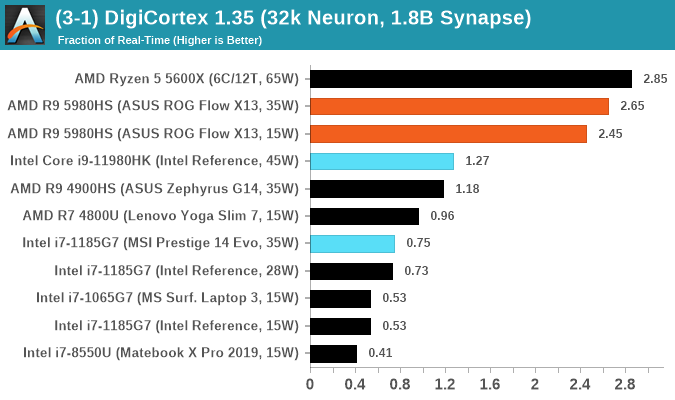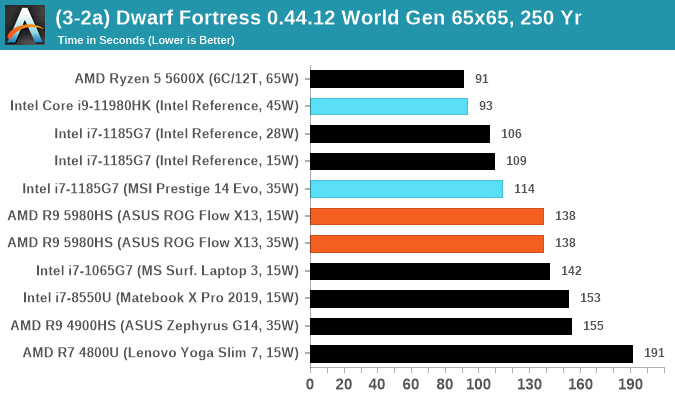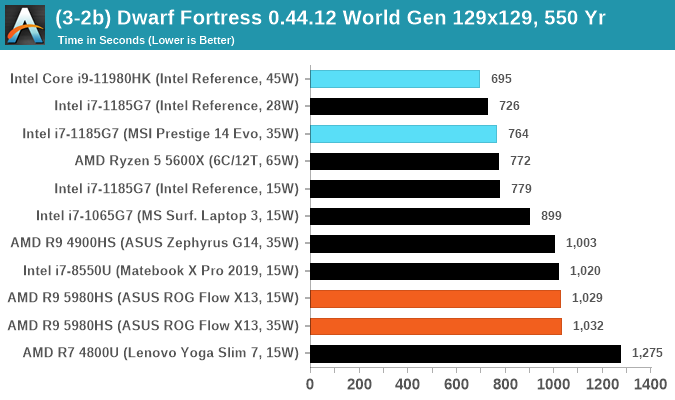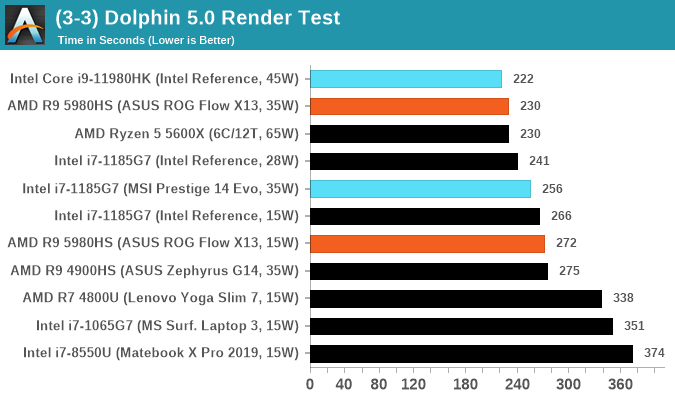Intel 11th Generation Core Tiger Lake-H Performance Review: Fast and Power Hungry
by Brett Howse & Andrei Frumusanu on May 17, 2021 9:00 AM EST- Posted in
- CPUs
- Intel
- 10nm
- Willow Cove
- SuperFin
- 11th Gen
- Tiger Lake-H
CPU Tests: Simulation
Simulation and Science have a lot of overlap in the benchmarking world, however for this distinction we’re separating into two segments mostly based on the utility of the resulting data. The benchmarks that fall under Science have a distinct use for the data they output – in our Simulation section, these act more like synthetics but at some level are still trying to simulate a given environment.
DigiCortex v1.35: link
DigiCortex is a pet project for the visualization of neuron and synapse activity in the brain. The software comes with a variety of benchmark modes, and we take the small benchmark which runs a 32k neuron/1.8B synapse simulation, similar to a small slug.
The results on the output are given as a fraction of whether the system can simulate in real-time, so anything above a value of one is suitable for real-time work. The benchmark offers a 'no firing synapse' mode, which in essence detects DRAM and bus speed, however we take the firing mode which adds CPU work with every firing.
The software originally shipped with a benchmark that recorded the first few cycles and output a result. So while fast multi-threaded processors this made the benchmark last less than a few seconds, slow dual-core processors could be running for almost an hour. There is also the issue of DigiCortex starting with a base neuron/synapse map in ‘off mode’, giving a high result in the first few cycles as none of the nodes are currently active. We found that the performance settles down into a steady state after a while (when the model is actively in use), so we asked the author to allow for a ‘warm-up’ phase and for the benchmark to be the average over a second sample time.
For our test, we give the benchmark 20000 cycles to warm up and then take the data over the next 10000 cycles seconds for the test – on a modern processor this takes 30 seconds and 150 seconds respectively. This is then repeated a minimum of 10 times, with the first three results rejected. Results are shown as a multiple of real-time calculation.

Dwarf Fortress 0.44.12: Link
Another long standing request for our benchmark suite has been Dwarf Fortress, a popular management/roguelike indie video game, first launched in 2006 and still being regularly updated today, aiming for a Steam launch sometime in the future.
Emulating the ASCII interfaces of old, this title is a rather complex beast, which can generate environments subject to millennia of rule, famous faces, peasants, and key historical figures and events. The further you get into the game, depending on the size of the world, the slower it becomes as it has to simulate more famous people, more world events, and the natural way that humanoid creatures take over an environment. Like some kind of virus.
For our test we’re using DFMark. DFMark is a benchmark built by vorsgren on the Bay12Forums that gives two different modes built on DFHack: world generation and embark. These tests can be configured, but range anywhere from 3 minutes to several hours. After analyzing the test, we ended up going for three different world generation sizes:
- Small, a 65x65 world with 250 years, 10 civilizations and 4 megabeasts
- Medium, a 127x127 world with 550 years, 10 civilizations and 4 megabeasts
- Large, a 257x257 world with 550 years, 40 civilizations and 10 megabeasts
DFMark outputs the time to run any given test, so this is what we use for the output. We loop the small test for as many times possible in 10 minutes, the medium test for as many times in 30 minutes, and the large test for as many times in an hour.


Dolphin v5.0 Emulation: Link
Many emulators are often bound by single thread CPU performance, and general reports tended to suggest that Haswell provided a significant boost to emulator performance. This benchmark runs a Wii program that ray traces a complex 3D scene inside the Dolphin Wii emulator. Performance on this benchmark is a good proxy of the speed of Dolphin CPU emulation, which is an intensive single core task using most aspects of a CPU. Results are given in seconds, where the Wii itself scores 1051 seconds.













229 Comments
View All Comments
boozed - Monday, May 17, 2021 - link
"Power Hungry" lol shock mesellappa - Monday, May 17, 2021 - link
Searched for "battery life" and couldn't find it. Waiting for battery life data.Brett Howse - Monday, May 17, 2021 - link
This is an engineering sample. We won't be doing battery life testing on it.mode_13h - Monday, May 17, 2021 - link
> This is an engineering sample. We won't be doing battery life testing on it.WTF? You mean the CPU isn't final production-run? If so, why is this labelled a "review" and not a "preview"?
Dolda2000 - Monday, May 17, 2021 - link
The laptop is an engineering sample, not the CPU.Andrei Frumusanu - Tuesday, May 18, 2021 - link
We purposefully called it "Performance Review" of the CPU in the title.The laptop itself is generally irrelevant as you will not be able to buy it, besides the fact that it's a an engineering sample.
mode_13h - Tuesday, May 18, 2021 - link
> it's a an engineering sample.Do you use the terms "engineering sample" and "reference design" interchangeably, or is there a significant distinction?
mode_13h - Tuesday, May 18, 2021 - link
FWIW, I think there *is* a distinction and that the laptop is really a reference design. If Intel were selling their own laptops, then you could call a pre-release laptop an "engineering sample". If it's just a demonstration vehicle for their chips, then it's a "reference design".Where the waters could get muddy is if Intel's lawyers have a lot of scary contracts threatening to sue you into oblivion if you sell on an engineering sample, as sometimes happens. And maybe they just chose to call the laptop an "engineering sample", so they could reuse those same legal agreements, rather than having to edit them so they instead apply to its reference boards/laptops.
isthisavailable - Monday, May 17, 2021 - link
AMD clearly has the "flagship" laptop CPU yet Intel still has the audacity to make new high end laptops exclusive to their processors by bribing OEMs.Spunjji - Tuesday, May 18, 2021 - link
To be fair, some of the OEMs do not seem to require any bribery.